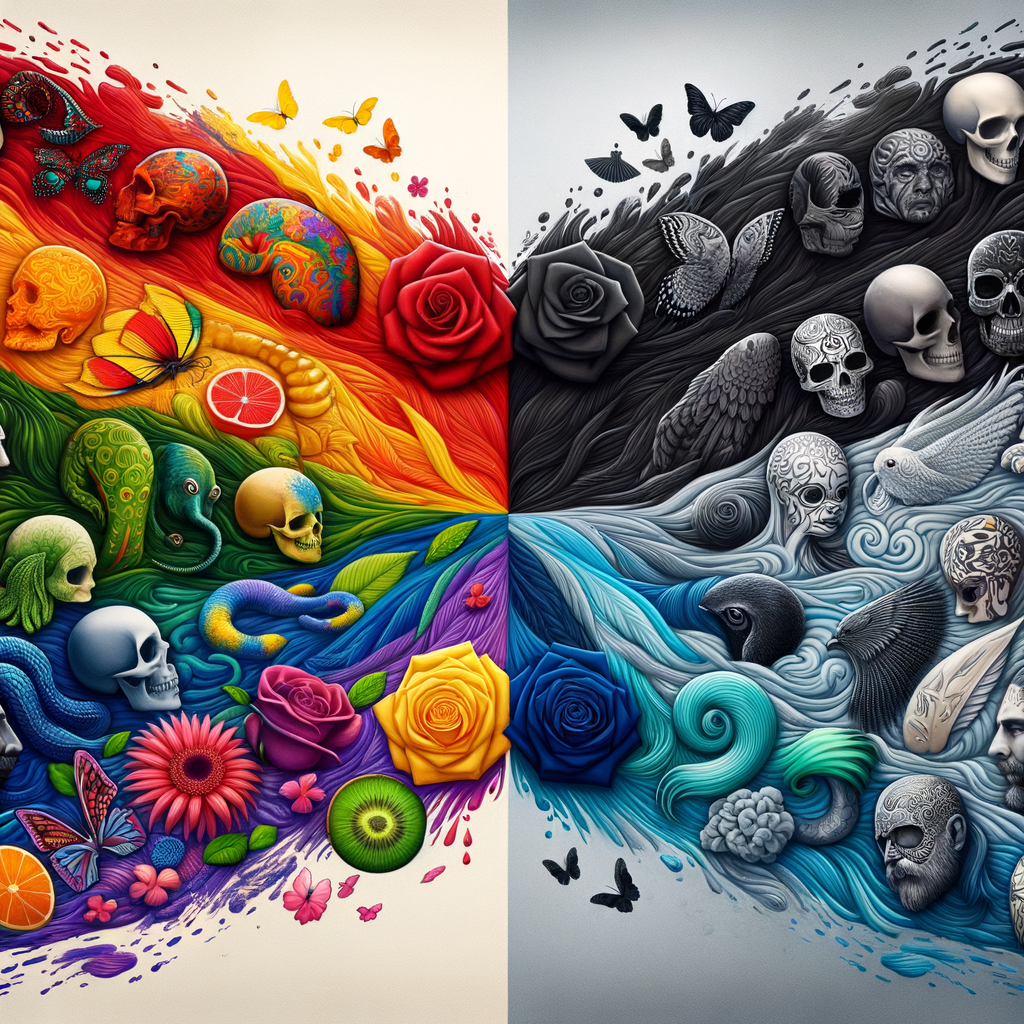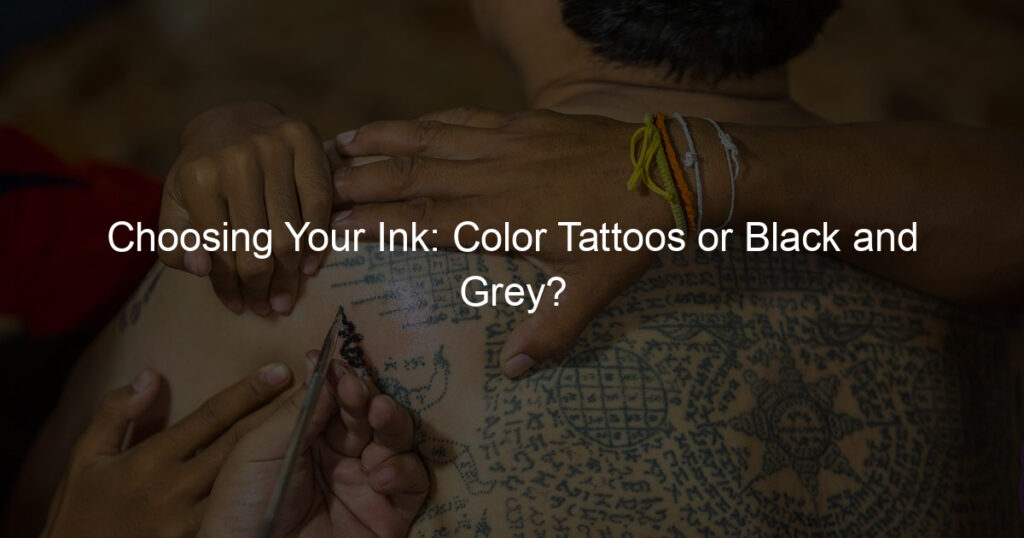
Introduction to Choosing Your Ink
When it comes to tattoos, the choice of ink color is as crucial as the design itself. The right color can enhance the visual appeal of your tattoo, making it a true reflection of your personality and style. This section will guide you through the importance of making the right tattoo color decision and compare the two main types of tattoos: color tattoos and black and grey tattoos.
Choosing the right color for your tattoo is not just about aesthetics. It’s about making sure your tattoo looks good now and for years to come. The right color can enhance the details of your tattoo, making it more vibrant and eye-catching. On the other hand, a poor color choice can make your tattoo look dull and unattractive.
Moreover, different colors fade at different rates. For instance, black ink tends to last longer than lighter colors. Therefore, your color choice will also impact the longevity of your tattoo. It’s important to consider these factors when choosing your ink color.
Color tattoos and black and grey tattoos each have their unique appeal. Color tattoos are vibrant and can make your design pop. They are perfect for intricate designs that require a variety of shades to bring out the details. However, they may require more maintenance as colors can fade over time.
On the other hand, black and grey tattoos are classic and timeless. They are known for their depth and contrast, which can give a three-dimensional effect to your design. Black and grey tattoos also tend to age well, with the ink staying sharp and clear for many years.
Ultimately, the choice between color tattoos and black and grey tattoos depends on your personal preference and the design of your tattoo. It’s important to discuss your options with your tattoo artist to ensure you make the best decision.
Understanding Color Tattoos
Color tattoos are a vibrant and expressive form of body art that has been gaining popularity over the years. Let’s delve into what color tattoos are and their history.
What are Color Tattoos?
Color tattoos are a type of tattoo that utilizes a variety of colored inks to create a visually striking design. Unlike black and grey tattoos, which rely on shades of black, white, and grey, color tattoos can incorporate the entire spectrum of colors.
- Definition and examples of color tattoos
A color tattoo is a permanent body modification that uses colored ink to create a design on the skin. The design can be anything from a simple heart or star to a complex portrait or landscape. For instance, a butterfly tattoo could be filled with vibrant blues and purples, or a rose tattoo might be inked in rich reds and greens. The possibilities are endless with color tattoos. - History and evolution of color tattoos
The history of color tattoos dates back thousands of years. Ancient civilizations, such as the Egyptians and Mayans, used natural pigments to create colorful body art. Over time, the techniques and materials used in color tattoos have evolved. In the 20th century, advancements in tattooing technology and ink production led to a wider range of colors and more precise application methods. Today, color tattoos are more vibrant and detailed than ever before, thanks to continuous advancements in the field.
Color tattoos offer a unique way to express oneself and can be a beautiful addition to one’s body art collection. However, it’s important to understand their history and what they entail before deciding to get one.
Pros and Cons of Color Tattoos
When it comes to tattoos, color can make a big difference. Let’s take a look at the advantages and disadvantages of choosing color tattoos.
-
- Advantages of Choosing Color Tattoos
Color tattoos can be a vibrant and expressive choice. Here are some reasons why you might want to consider them:
-
-
- Variety: With color tattoos, you have a wide range of colors to choose from. This allows for more creativity and personalization in your tattoo design.
- Visibility: Color tattoos can stand out more than black and grey tattoos, especially on darker skin tones.
- Expression: Colors can convey different emotions and meanings. For example, red can symbolize passion, while blue can represent calmness.
- Disadvantages of Choosing Color Tattoos
-
While color tattoos have their benefits, they also come with some drawbacks:
-
- Fading: Color tattoos can fade faster than black and grey tattoos, especially when exposed to sunlight. This might require more frequent touch-ups.
- Cost: Color tattoos can be more expensive than black and grey tattoos because they require more ink and time to create.
- Allergies: Some people might be allergic to certain tattoo inks, particularly colored ones. It’s important to discuss this with your tattoo artist before getting a color tattoo.
In conclusion, color tattoos can be a great way to express your individuality and creativity. However, they also require more maintenance and can be more costly. It’s important to weigh these pros and cons before deciding on a color tattoo.
Understanding Black and Grey Tattoos
When it comes to body art, black and grey tattoos are a timeless choice. This section will delve into what black and grey tattoos are, their history, and their evolution over time.
What are Black and Grey Tattoos?
Black and grey tattoos are a style of tattooing that uses only black ink in varying shades. This is achieved by diluting the black ink with distilled water in various proportions, creating a “wash” of lighter shades. The diluted black ink is used to fill in spaces, create gradients and give the illusion of depth and shadows. This technique results in a monochromatic piece of body art that resembles a black-and-white photograph.
-
- Definition and examples of black and grey tattoos: Black and grey tattoos are defined by their use of only black ink and water to create a range of greys. Examples of this style include portrait tattoos, where the artist replicates a photograph in black and grey. Other popular designs in this style are skulls, roses, and religious symbols. These tattoos are known for their realism and depth.
- History and evolution of black and grey tattoos: The black and grey tattoo style originated in the prison system, where inmates had limited resources. They used what was available – usually a single color of ink – and improvised with water to create different shades. This style was later popularized in the 1970s by artists in East Los Angeles and has since become a staple in mainstream tattoo culture. Over time, the techniques have been refined and the designs have become more intricate, but the core principle of using only black ink and water remains the same.
Black and grey tattoos are a testament to the power of simplicity. They demonstrate how a single color can be manipulated to create depth, texture, and intricate designs. Whether you’re considering a portrait, a symbol, or a custom design, black and grey tattoos offer a timeless and versatile option.
Pros and Cons of Black and Grey Tattoos
-
- Advantages of Choosing Black and Grey Tattoos
Black and grey tattoos have a number of advantages that make them a popular choice for many people. Here are some of the key benefits:
-
-
- Timeless Appeal: Black and grey tattoos have a classic look that doesn’t fade with time or fashion trends. They can look as good in 20 years as they do today.
- Detail and Depth: The shades of black and grey can create a sense of depth and detail that is hard to achieve with color tattoos. This makes them ideal for designs that require intricate details.
- Less Fading: Black and grey tattoos tend to fade less than color tattoos, meaning they can stay looking sharp and clear for longer.
- Lower Cost: Generally, black and grey tattoos are cheaper than their color counterparts as they require less ink.
- Disadvantages of Black and Grey Tattoos
-
While black and grey tattoos have many advantages, they also have some downsides. Here are a few things to consider:
-
- Lack of Color: The most obvious disadvantage is the lack of color. If you want a vibrant, colorful tattoo, black and grey might not be the best choice for you.
- Less Visible on Dark Skin: Black and grey tattoos can be less visible on darker skin tones. They may not stand out as much as color tattoos.
- Design Limitations: Some designs, especially those that rely on color for impact or symbolism, may not translate well to black and grey.
Choosing Tattoo Colors: Factors to Consider
When it comes to choosing the right colors for your tattoo, there are several factors to consider. It’s not just about picking your favorite color. You need to consider your skin tone, personal style, tattoo placement, and the symbolism of the colors you choose. Let’s delve into these factors in more detail.
-
- Skin Tone and Tattoo Color Choice
Your skin tone plays a significant role in how your tattoo will look. Lighter colors like yellow, pink, and light blue may not show up as vibrantly on darker skin tones as they do on lighter ones. On the other hand, darker colors like black, navy, and deep red can stand out beautifully on all skin tones. It’s important to consult with your tattoo artist about the best color choices for your skin tone.
-
- Personal Style and Tattoo Color
Your personal style should also influence your tattoo color choice. If you prefer a classic, timeless look, you might opt for a black and grey tattoo. If you’re more adventurous and love color, a vibrant, multi-colored tattoo could be the perfect fit. Remember, your tattoo is a reflection of you, so choose colors that resonate with your personal style.
-
- Tattoo Placement and Color
The placement of your tattoo can also affect your color choice. Certain areas of the body, like the hands and feet, tend to fade faster due to constant exposure and friction. In these cases, darker colors might be a better choice as they tend to fade slower. On less exposed areas, you can experiment with a wider range of colors.
-
- Symbolism and Color in Tattoos
Lastly, consider the symbolism of the colors you choose. Different colors can represent different things. For example, red can symbolize love and passion, while blue can represent calmness and peace. If you’re getting a tattoo to commemorate a person or event, consider choosing colors that hold symbolic meaning.
In conclusion, choosing the right colors for your tattoo involves considering your skin tone, personal style, tattoo placement, and the symbolism of the colors. By taking these factors into account, you can ensure that your tattoo not only looks great but also holds personal significance for you.
Tattoo Color vs Black and Grey: Making Tattoo Choices
When it comes to tattoos, one of the most important decisions you’ll make is whether to go with color or stick to black and grey. Both options have their own unique appeal and can create stunning results when done well. Let’s look at some successful examples of color tattoos to help you make an informed decision.
Case Studies: Successful Color Tattoos
Color tattoos can be vibrant and eye-catching, adding a unique aesthetic to your body art. Here are a couple of case studies that showcase the beauty and versatility of color tattoos.
-
- Case Study 1: One of the most famous color tattoos is the “Rainbow Phoenix” done by renowned tattoo artist, Kat Von D. This tattoo features a phoenix bird, a symbol of rebirth and renewal, adorned in a spectrum of colors. The vibrant hues against the skin create a stunning contrast, making the tattoo a true work of art.
- Case Study 2: Another successful color tattoo is the “Watercolor Lion” by Amanda Wachob. This tattoo uses a watercolor painting technique, resulting in a beautiful, soft blend of colors. The lion, a symbol of strength and courage, is rendered in shades of blue, purple, and pink, creating an ethereal and captivating image.
These case studies illustrate the potential of color tattoos to create visually striking and meaningful body art. Whether you’re drawn to the bold, vibrant colors of the Rainbow Phoenix or the soft, dreamy hues of the Watercolor Lion, color tattoos offer a wide range of possibilities for personal expression.
Case Studies: Successful Black and Grey Tattoos
Let’s delve into two fascinating case studies that showcase the beauty and depth of black and grey tattoos.
-
Case Study 1: The Majestic Lion
Our first case study is a majestic lion tattoo, a testament to the power of black and grey ink. The artist used varying shades of black and grey to create a stunningly realistic lion’s face. The darker shades were used to highlight the lion’s mane and eyes, while the lighter shades were used to give depth and texture to the lion’s face.
The result was a tattoo that not only looked realistic but also had a depth and dimension that is hard to achieve with color tattoos. This case study shows that black and grey tattoos can be just as detailed and visually striking as color tattoos.
-
Case Study 2: The Intricate Mandala
Our second case study is an intricate mandala tattoo. The artist used black and grey ink to create a complex and detailed design. The black ink was used to outline the mandala, while the grey ink was used to fill in the design and create a sense of depth.
The result was a tattoo that was not only visually stunning but also had a depth and complexity that would have been hard to achieve with color ink. This case study demonstrates the versatility of black and grey tattoos and their ability to create intricate and detailed designs.
In conclusion, these case studies demonstrate that black and grey tattoos can be just as visually striking and detailed as color tattoos. They showcase the versatility of black and grey ink and its ability to create depth, dimension, and intricate designs.
Conclusion: Best Tattoo Colors for You
Deciding on the best tattoo color for you is a personal journey that involves understanding your skin tone, personal style, and the symbolism behind the colors. Whether you opt for vibrant color tattoos or the classic black and grey, your choice should reflect who you are and what you want your tattoo to represent.
-
- Key takeaways on choosing the right tattoo color
Choosing the right tattoo color is not just about picking your favorite color. It involves considering factors such as your skin tone, the tattoo’s location, and the design’s intricacy. Light colors like yellow and white may not show up well on darker skin tones, while darker colors like black and blue can stand out on any skin tone. The tattoo’s location can also affect the color choice. For example, areas that are exposed to the sun may fade faster, so darker colors may be a better choice. Lastly, intricate designs may require a variety of colors to highlight the details.
-
- Final thoughts on color tattoos vs black and grey tattoos
Color tattoos can be vibrant and eye-catching, allowing for a wide range of artistic expression. They can bring a design to life with their vivid hues. However, they may require more maintenance as colors can fade over time, especially with sun exposure.
On the other hand, black and grey tattoos are timeless and can create a striking contrast on the skin. They tend to age well and require less touch-ups. However, they may not be as vibrant or colorful as color tattoos.
Ultimately, the choice between color tattoos and black and grey tattoos comes down to personal preference and the desired effect of the tattoo.
In conclusion, the best tattoo colors for you depend on various factors. It’s important to take your time, do your research, and consult with a professional tattoo artist to make an informed decision. Remember, a tattoo is a form of self-expression, so choose colors that best represent you and your story.














